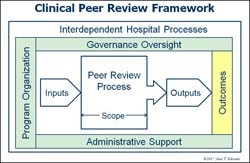The Clinical Peer Review Enhancement ProgramSM aka PREPSM
Consulting Services and Tools for QI Model Clinical Peer Review
Why try to re-invent the wheel? Let us help you achieve your goals quickly and painlessly.
Key Benefits
- Opens the untapped reservoir of opportunity to improve healthcare quality and safety
- Engages the medical and nursing staff to improve clinical performance
- Enhances physician-hospital relations
- Enables data-rich focused and ongoing professional practice evaluation (FPPE/OPPE)
- Participate in and benchmark against our normative database on peer review process and outcomes
- Join in our ongoing research agenda to publish studies on the impact of robust peer review process on the quality and safety of care, and on other relevant outcome variables

PREPSM Overview
For more detail, see the PREPSM Online Brochure
Most physician leaders recognize that the QA approach to peer review has failed, but don't know what to do about it. By applying a systems theory framework to our research initiatives and client work, we've evolved a new model for the peer review process that replaces QA with QI. It is simple in concept, but represents an important shift in mindset, particularly in terms of understanding the power of clinical performance measurement against the old-fashioned approach to categorizing care as meeting or not meeting standards.
The QI Model for Clinical Peer Review
- Distinguish between performance and competence
- View peer review as clinical performance measurement and improvement
- Use contemporary case review methods to reliably measure clinical performance
- Standardize review committee processes
- Rationalize the connection with the hospital's performance improvement function
- In each review, seek out whatever can be learned to improve both individual performance and the process of care
- Train reviewers, committee chairs and support staff
- Harness the power of information systems to periodically aggregate data and analyze trends
- Provide timely and balanced performance feedback, including the recognition of excellence
- Track the outcomes of peer review
- Establish effective process governance and continue to make incremental improvements
- Keep the Trustees informed of the impact of peer review on quality and safety
- Promote self-reporting of adverse events, near misses and hazardous conditions under the protection of a Patient Safety Organization relationship
PREPSM Features
- Standardized and adaptable methodology
- Templates to speed design of structured review tools and program policy
- Reviewer and support staff training
- Implementation assistance
- Follow up program impact assessment
Links
- PREPSM Online Brochure
- The QI Model
- The History of the QA Model
- Online Clinical Peer Review Program Self-Evaluation Tool
Whitepapers
Products & Services
- PREP-MSTM: Program Management Software
- My PREPTM: The Complete Toolkit for Program Improvement
- Site Visit: A Jump-Start for Improvement
- DataDriverSM: Accelerated Improvement
- From QA to QISM: Custom Solutions
- Medical Staff Opinion Survey
- Professional Fees and Product Pricing
- Client Testimonials
- Client Results